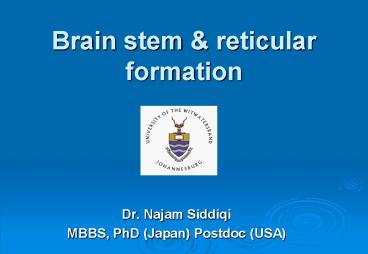Brain stem - PowerPoint PPT Presentation
1 / 38
Title:
Brain stem
Description:
Brain stem & reticular formation Dr. Najam Siddiqi MBBS, PhD (Japan) Postdoc (USA) What is brain stem ? Medulla oblongata Pons Midbrain What are contents of brain stem? – PowerPoint PPT presentation
Number of Views:135
Avg rating:3.0/5.0
Title: Brain stem
1
Brain stem reticular formation
- Dr. Najam Siddiqi
- MBBS, PhD (Japan) Postdoc (USA)
2
What is brain stem ?
- Medulla oblongata
- Pons
- Midbrain
3
What are contents of brain stem?
- Ascending descending tracts
- Cranial nerve nuclei
- Reticular formation nuclei and fibres forming a
network - Other nuclei
4
Brain stem--Ventral view
5
Brain stem--Dorsal view
6
Midbrain at Superior Colliculus level
7
Oculomotor nerve (Pretectal Edinger-Westphal
nucleus)
8
Mid brain at Inferior colliculus level
9
Trochlear nerve (IV)
10
Pons
Ventral view
Dorsal view
11
Pons
12
(No Transcript)
13
Trigeminal nerve (V) (sensory/motor)
Muscles of mastication, tensor tympani, tensor
veli palatini, mylohyoid, digastric
14
Trigeminal nerve (sensory)
15
Abducent nerve (VI)
16
Facial nerve (VII) Sensory/parasympathetic
17
Medulla oblongata
18
Facial nerve (motor)
Muscles of facial expression, Post. belly of
digastric, STAPEDIUS
19
Medulla oblongata
20
Glossopharyngeal nerve (IX)
21
Vagus nerve (X)
- Parasympathetic nerve to the viscera Gut,
respiratory system, heart - Motor muscles of palate, pharynx, larynx
- Sensory larynx, trachea, gut, aortic arch
receptors, taste buds in post. oral cavity
22
Spinal accessory nerve (XI)
Striated muscles of larynx, Sternocleido-mastoid,
Trapezius
23
Hypoglossal nerve (XII) motor
Intrinsic muscles of the tongue, hyoglossus,
genioglossus, styloglossus
24
Olfactory nerve (I)
25
Optic nerve (II)
26
Vestibulocochlear nerve (VIII)
27
Reticular Formation (RF)
- Resembles a net of neurons and nerve fibers from
the spinal cord to the cerebrum - Separated by huge dendritic tree
- Connected by immense number of afferent and
efferent axons - Lie in brainstem tegmentum of midbrain, pons and
medulla - Extent to thalamus, hypothalamus, cerebrum
- Cranial nerve nuclei are not part of it
- It influence skeletal muscle activity, somatic
and visceral sensations, autonomic and endocrine
functions and level of consciousness
28
- Arousal of the brain as a whole
- Certain reticular neurons send continuous stream
of impulses to cortexkeeps the cortex alert and
conscious this part is called Reticular
Activating System (RAS) - RAS acts as a FILTER for the flood of sensory
inputs. Disregard almost 99 of all sensory
impulses as unimportant
29
Reticular Activating System (RAS)
- RAS is inhibited by sleep centers located in
hypothalamus - Depressed by alcohol, sleep inducing drugs,
tranquilizers - Severe injury to RAS result in irreversible coma
30
(No Transcript)
31
(No Transcript)
32
(No Transcript)
33
Motor activity
- Via reticulospinal tract, motor nuclei projects
to motor neurons in the spinal cord to help
control skeletal muscles - Other nuclei such as vasomotor, cardiac and
respiratory centers of medulla are automatic
centers regulate visceral motor functions
34
Nuclei of RF
- Midline column (Midline Raphe nuclei) extent the
entire length of the median/paramedian plane of
brainstem - Medial column (Medial gigantocellular--large
cell nuclei) pontomedullary tegmentum - Lateral column (Lateral parvicellular small cell
nuclei) from medullocervical region to midbrain - Cerebellar reticular formation nuclei connected
to cerebellum
35
Afferents
- Ascending and descending pathways
- Auditory and optic pathways
- Spinal afferents includes spinoreticular tracts
- Spinothalamic tract from thalamus, subthalamus,
epithalamus, corpus striatum, limbic system - Brainstem afferents includes sensory tracts from
Trigeminal, Cochlear, vestibular nuclei. - Tectoreticulat tract
- Reticuloreticular tract
- Cerebellar afferents
36
Afferents
- Limbic afferents includes Habenular nuclei,
mamillary bodies - Hypothalamus afferents
- Basal ganglia afferents
- Cerebral cortex afferents
37
Efferent projections
- Reticulobulbar tract-cranial nerve nuclei
- Reticulospinal tractanterior horn cells of
spinal cord - Reticulothalamic tract-- to thalamus,
hypothalamus - Limbic system, cerebral cortex, red nucleus,
corpus striatum, cerebellum, tectum, - To sympathetic and parasympathetic outflow
38
Functions
- 1. Control of muscle tone and reflexes mediates
postural reflexes through alpha and gamma motor
neurons - 2. Muscles of facial expression
- 3. Influence all ascending pathways Central
transmission of sensory impulses - 4. Control of Autonomic nervous system
- Respiration, Cardiovascular functions
39
Functions
- 5. Arousal and level of consciousness Ascending
reticular formation system stimulation will
arouse the sleeping person, mediates alerting
responses and consciousness and maintain the
cerebrum in a waking state - 6. Influence on the biological clock--Sleep
serotonin-secreting neurons in raphe nuclei
mediate non-REM sleep - 7. Control of endocrine nervous system
40
Sleep disorders
- Somnambuslim (sleep walking)
- Enuresis
- Narcolepsy
- Cataplexy an attack of paralysis of somatic
muscles precipitated by bouts of laughter or
crying/strong emotional stimuli
41
Hang on
42
(No Transcript)
43
(No Transcript)
44
(No Transcript)































